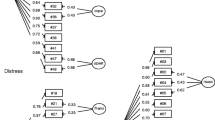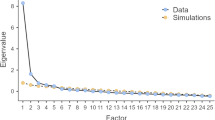Abstract
The aim of the present study was to evaluate the psychometric properties of the Discomfort Sensitivity Scale (DSS) using exploratory and confirmatory factor analyses in independent symptomatic (i.e., clinically elevated levels of depressive symptoms) and non-symptomatic subsamples. Participants were 846 undergraduate students (Mage = 19.28, SD = 2.52; 70.0% female; 85.6% Caucasian) that were split into non-symptomatic EFA (n = 286), non-symptomatic CFA (n = 286), and symptomatic CFA (n = 274) subsamples. The EFAs resulted in a 1-factor solution with 8 items. Subsequent CFAs in the symptomatic and non-symptomatic subsamples also supported a one-factor solution. The DSS demonstrated excellent internal consistency, reliability, and construct validity in its associations with other measures of psychopathology. The DSS appears to be a psychometrically sound measure of sensitivity to physical discomfort that is appropriate for use in clinical and non-clinical samples.
Similar content being viewed by others
Notes
As the goal of the current study was to revise the DIS, we had intended to name the measure the Discomfort Intolerance Scale—Revised. However, the final measure did not contain any of the original DIS items, and the items that were retained appear to assess sensitivity to or dislike of physical discomfort rather than intolerance of physical discomfort. As such, we did not feel using DIS in the name would be appropriate and chose to name the measure the Discomfort Sensitivity Scale.
References
Alberts, N. M., Hadjistavropoulos, H. D., Jones, S. L., & Sharpe, D. (2013). The Short Health Anxiety Inventory: A systematic review and meta-analysis. Journal of Anxiety Disorders, 27(1), 68–78. https://doi.org/10.1016/j.janxdis.2012.10.009
Bentler, P. M. (1990). Comparative fit indexes in structural models. Psychological Bulletin, 107(2), 238–246. https://doi.org/10.1037/0033-2909.107.2.238
Bentler, P. M., & Bonett, D. G. (1980). Significance tests and goodness of fit in the analysis of covariance structures. Psychological Bulletin, 88(3), 588–606. https://doi.org/10.1037/0033-2909.88.3.588
Bonn-Miller, M. O., Zvolensky, M. J., & Bernstein, A. (2009). Discomfort intolerance: Evaluation of incremental validity for panic-relevant symptoms using 10% carbon dioxide-enriched air provocation. Journal of Anxiety Disorders, 23(2), 197–203. https://doi.org/10.1016/j.janxdis.2008.06.007
Brown, T. A., Antony, M. M., & Barlow, D. H. (1992). Psychometric properties of the Penn State Worry Questionnaire in a clinical anxiety disorders sample. Behaviour Research and Therapy, 30(1), 33–37. https://doi.org/10.1016/0005-7967(92)90093-V
Browne, M. W., & Cudeck, R. (1993). Alternative ways of assessing model fit. In K. Bollen & J. S. Long (Eds.), Testing structural equation models (pp. 136–162). Sage Publications.
Buckner, J. D., Keough, M. E., & Schmidt, N. B. (2007). Problematic alcohol and cannabis use among young adults: The roles of depression and discomfort and distress tolerance. Addictive Behaviors, 32(9), 1957–1963. https://doi.org/10.1016/j.addbeh.2006.12.019
Costello, A. B., & Osborne, J. W. (2005). Best practices in exploratory factor analyses: Four recommendations for getting the most from your analysis. Practical Assessment, Research, & Evaluation, 10, 1–9. https://doi.org/10.7275/jyj1-4868
Everitt, B. (1975). Multivariate analysis: The need for data, and other problems. British Journal of Psychiatry, 126(3), 237–240. https://doi.org/10.1192/bjp.126.3.237
Guadagnoli, E., & Velicer, W. F. (1988). Relation to sample size to the stability of component patterns. Psychological Bulletin, 103(2), 265–275. https://doi.org/10.1037/0033-2909.103.2.265
Harris, P. A., Taylor, R., Thielke, R., Payne, J., Gonzalez, N., & Conde, J. G. (2009). Research electronic data capture (REDCap)—A metadata-driven methodology and workflow process for providing translational research informatics support. Journal of Biomedical Informatics, 42(2), 377–381. https://doi.org/10.1016/j.jbi.2008.08.010
Howell, A. N., Leyro, T. M., Hogan, J., Buckner, J. D., & Zvolensky, M. J. (2010). Anxiety sensitivity, distress tolerance, and discomfort intolerance in relation to coping and conformity motives for alcohol use and alcohol use problems among young adult drinkers. Addictive Behaviors, 35(12), 1144–1147. https://doi.org/10.1016/j.addbeh.2010.07.003
Hu, L. T., & Bentler, P. M. (1999). Cutoff criteria for fit indexes in covariance structure analysis: Conventional criteria versus new alternatives. Structural Equation Modeling: A Multidisciplinary Journal, 6(1), 1–55. https://doi.org/10.1080/10705519909540118
Kutz, A., Marshall, E., Bernstein, A., & Zvolensky, M. J. (2010). Evaluating emotional sensitivity and tolerance factors in the prediction of panic-relevant responding to a biological challenge. Journal of Anxiety Disorders, 24(1), 16–22. https://doi.org/10.1016/j.janxdis.2009.07.025
Leyro, T. M., Zvolensky, M. J., Vujanovic, A. A., & Bernstein, A. (2008). Anxiety sensitivity and smoking motives and outcome expectancies among adult daily smokers: Replication and extension. Nicotine & Tobacco Research, 10(6), 985–994. https://doi.org/10.1080/14622200802097555
Luberto, C. M., Carle, A. C., & McLeish, A. C. (2013). Confirmatory factor analysis of the Discomfort Intolerance Scale. International Journal of Cognitive Therapy, 6(4), 358–370. https://doi.org/10.1521/ijct.2013.6.4.358
Marshall, E. C., Vujanovic, A. A., Kutz, A., Gibson, L., Leyro, T., & Zvolensky, M. J. (2009). Reasons for quitting smoking prior to a self-quit attempt among smokers with and without posttraumatic stress disorder or other anxiety/mood psychopathology. American Journal on Addictions, 18(4), 309–315. https://doi.org/10.1080/10550490902925763
Matsunaga, M. (2010). How to factor-analyze your data right: Do’s don’ts and how-to’s. International Journal of Psychological Research, 3(1), 97–110. https://doi.org/10.21500/20112084.854
McLeish, A. C., Kraemer, K. M., & O’Bryan, E. M. (2019). Discomfort intolerance in relation to asthma outcomes. Cognitive Therapy and Research, 43, 24–31. https://doi.org/10.1007/s10608-018-9965-y
Meyer, T. J., Miller, M. L., Metzger, R. L., & Borkovec, T. D. (1990). Development and validation of the Penn State Worry Questionnaire. Behaviour Research and Therapy, 28(6), 487–495. https://doi.org/10.1016/0005-7967(90)90135-6
Muthén, L. K., & Muthén, B. (2010). Mplus 6.0. Muthén & Muthén.
Nunnally, J. (1978). Psychometric theory (2nd Ed.). McGraw-Hill.
Radloff, L. S. (1977). The CES-D scale: A self-report depression scale for research in the general population. Applied Psychological Measurement, 1(3), 385–401. https://doi.org/10.1177/014662167700100306
Salkovskis, P. M., Rimes, K. A., Warwick, H. M. C., & Clark, D. M. (2002). The Health Anxiety Inventory: Development and validation of scales for the measurement of health anxiety and hypochondriasis. Psychological Medicine, 32(5), 843–853. https://doi.org/10.1017/S0033291702005822
Schmidt, N. B., & Cook, J. H. (1999). Effects of anxiety sensitivity on anxiety and pain during a cold pressor challenge in patients with panic disorder. Behaviour Research and Therapy, 37(4), 313–323. https://doi.org/10.1016/S0005-7967(98)00139-9
Schmidt, N. B., Lerew, D. R., & Trakowski, J. H. (1997). Body vigilance in panic disorder: Evaluating attention to bodily perturbations. Journal of Consulting and Clinical Psychology, 65(2), 214–220. https://doi.org/10.1037/0022-006X.65.2.214
Schmidt, N. B., Richey, J. A., & Fitzpatrick, K. K. (2006). Discomfort intolerance: Development of a construct and measure relevant to panic disorder. Journal of Anxiety Disorders, 20(3), 263–280. https://doi.org/10.1016/j.janxdis.2005.02.002
Schmidt, N. B., Richey, J. A., Cromer, K. R., & Buckner, J. D. (2007). Discomfort intolerance: Evaluation of a potential risk factor for anxiety psychopathology. Behavior Therapy, 38(3), 247–255. https://doi.org/10.1016/j.beth.2006.08.004
Simons, J. S., & Gaher, R. M. (2005). The Distress Tolerance Scale: Development and validation of a self-report measure. Motivation and Emotion, 29(2), 83–102. https://doi.org/10.1007/s11031-005-7955-3
Spielberger, C. D., Gorsuch, R. L., Lushene, R., Vagg, P. R., & Jacobs, G. A. (1983). Manual for the State-Trait Anxiety Inventory. Self-evaluation questionnaire. Consulting Psychologists Press.
Spielberger, C. D. (1989). State-Trait Anxiety Inventory: A comprehensive bibliography. Consulting Psychologists Press.
Stasik-O’Brien, S. M., Brock, R. L., Chmielewski, M., Naragon-Gainey, K., Koffel, E., McDade-Montez, E., O’Hara, M. W., & Watson, D. (2018). Clinical utility of the Inventory of Depression and Anxiety Symptoms (IDAS). Assessment, 26(5), 1–17. https://doi.org/10.1177/1073191118790036
Tabachnick, B. G., & Fidell, L. S. (2019). Using multivariate statistics (7th ed.). Pearson.
Taylor, S., Zvolensky, M. J., Cox, B. J., Deacon, B., Heimberg, R. G., Ledley, D. R., & Coles, M. (2007). Robust dimensions of anxiety sensitivity: Development and initial validation of the Anxiety Sensitivity Index-3. Psychological Assessment, 19(2), 176–188. https://doi.org/10.1037/1040-3590.19.2.176
Vujanovic, A. A., Marshall, E. C., Gibson, L. E., & Zvolensky, M. J. (2010). Cognitive–affective characteristics of smokers with and without posttraumatic stress disorder and panic psychopathology. Addictive Behaviors, 35(5), 419–425. https://doi.org/10.1016/j.addbeh.2009.12.005
Watson, D., O’hara, M. W., Simms, L. J., Kotov, R., Chmielewski, M., McDade-Montez, E. A., Gamez, W., & Stuart, S. (2007). Development and validation of the Inventory of Depression and Anxiety Symptoms (IDAS). Psychological Assessment, 19(3), 253–268. https://doi.org/10.1037/1040-3590.19.3.253
Watson, D., O’hara, M. W., Chmielewski, M., McDade-Montez, E. A., Koffel, E., Naragon, K., & Stuart, S. (2008). Further validation of the IDAS: Evidence of convergent, discriminant, criterion, and incremental validity. Psychological Assessment, 20(3), 248–259. https://doi.org/10.1037/a0012570
Author information
Authors and Affiliations
Contributions
ACM, ALJ, CML, and EMO developed the measure and designed the study; EMO collected the data; ALJ, CML, and EMO analyzed the data and drafted the “Methods” and “Results” sections. ACM wrote the first draft of the manuscript, and ALJ, CML, and EMO provided significant input in revising the manuscript drafts. All authors contributed to and have approved the final manuscript.
Corresponding author
Ethics declarations
Conflict of Interest
The authors declare no competing interests.
Additional information
Publisher's Note
Springer Nature remains neutral with regard to jurisdictional claims in published maps and institutional affiliations.
Appendix
Appendix
Table
Rights and permissions
Springer Nature or its licensor holds exclusive rights to this article under a publishing agreement with the author(s) or other rightsholder(s); author self-archiving of the accepted manuscript version of this article is solely governed by the terms of such publishing agreement and applicable law.
About this article
Cite this article
McLeish, A.C., Johnson, A.L., Luberto, C.M. et al. Development and Initial Evaluation of the Discomfort Sensitivity Scale. J Cogn Ther 15, 434–451 (2022). https://doi.org/10.1007/s41811-022-00146-w
Accepted:
Published:
Issue Date:
DOI: https://doi.org/10.1007/s41811-022-00146-w




